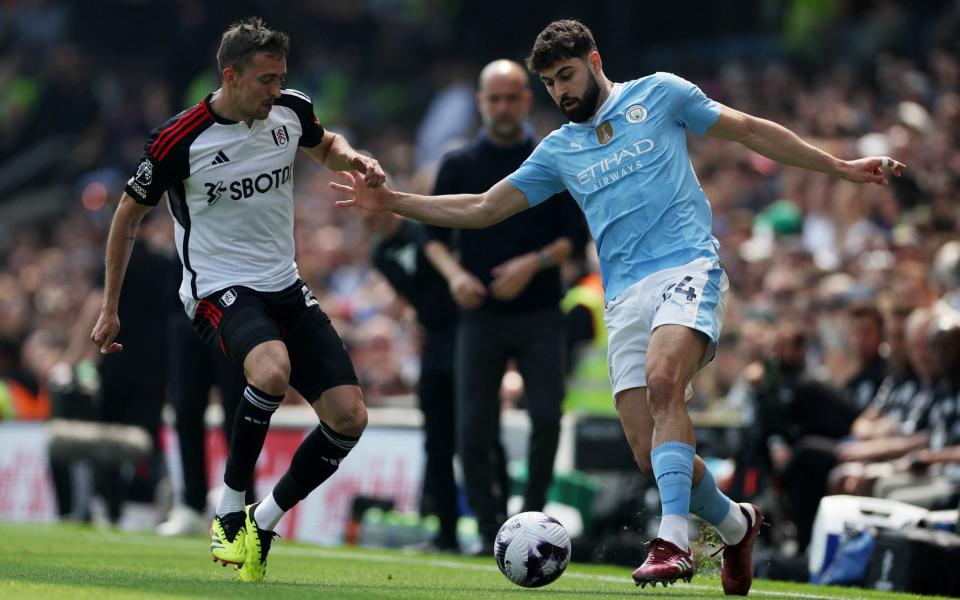The tactical trends that dominated the Premier League this season

Manchester City won the title, the three promoted teams were relegated and Manchester United were awful. In many respects the Premier League was very predictable indeed, but there was plenty to keep us interested along the way.
There were some outstanding coaching performances and pleasing stylistic clashes, even if Pep Guardiola continues to shape the tactical paradigm which dominates top-level football.
These are some of the statistical and tactical trends of the 2023-24 Premier League season.
Goals galore
More goals were scored in this Premier League season than any other. A total of 1,246 goals averages out at 3.28 goals per game, comfortably clear of 2022-23’s 2.85.
Those who prize entertainment got their money’s worth, and the majority Premier League teams now try to play proactive, front-footed football with all its associated risks. Since football’s data revolution, teams are more selective about the shots they take and adept at working the ball into high-value positions. Cut-backs have replaced crosses swung in from deep.
On the other hand, more goals could be viewed as a symptom of a more stratified competition. Man City, Liverpool and Arsenal were certainly a cut above the rest, while Sheffield United, Burnley and Luton Town were probably the weakest batch of promoted teams this century.
Changes to the game have also encouraged more goals, notably this season’s directive to add substantial periods of stoppage time. Interestingly, ball-in-play time is one area where City have a small edge on their rivals, most likely as a result of their measured, possession-based style. City’s average ball-in-play time was 4 minutes and 36 seconds longer than Arsenal’s and 5 minutes and 26 seconds longer than Liverpool’s. Across 38 games, that is a lot of ‘extra’ time to put to good use.
Predictably, more stoppage time has led to more late goals, as defences start to tire and lose concentration. This season has seen 112 goals scored after the 90th minute, with 2021-22 the previous high at 85. There have been 27 winning goals scored in this period, a new Premier League record. Liverpool scored the most late goals with 11 and three of those were winners, including Darwin Nunez’s 99th-minute header at Nottingham Forest.
Topsy-turvy games
This season saw more comeback victories than any campaign in Premier League history with 63, another reflection of more goals and more stoppage time.
Liverpool won an immense 28 points from losing positions, the most they have managed in any Premier League season. The fact they found themselves behind 18 times throughout the season possibly took an emotional and physical toll, however. City found themselves behind on 13 occasions while for Arsenal it was just 10.
Brentford dropped 30 points from winning positions, the most of any Premier League team since 2007-08.
With so much training ground focus on high pressing and build-up play from the back, teams are potentially less comfortable when they either choose or are forced to defend their penalty box. Fewer teams in the league are built to soak up pressure.
Managers are also learning to leverage their five substitutes. Four teams benefitted from more than 20 goal involvements from substitutes: Liverpool, Newcastle, Aston Villa and Arsenal.
Defending in a 4-4-2
When Antonio Conte won the Premier League with Chelsea using a 3-4-3 in 2016-17, it prompted a number of teams to move away from a back four to a back three or five. Wolves and Brentford are two teams who still use the system, while Oliver Glasner has revitalised Palace after switching to a 3-4-3. Nevertheless, there has been a shift towards a back four out of possession.
Pep Guardiola, Mikel Arteta, Jurgen Klopp, Unai Emery, Ange Postecoglou, Mauricio Pochettino, Eddie Howe, Erik ten Hag and David Moyes – coaches of the top nine Premier League teams – all prefer a back four. The same is true of Andoni Iraola at Bournemouth, Sean Dyche at Everton and Robert De Zerbi at (or formerly of) Brighton.
These coaches may use different pressing schemes and choose to engage opponents higher or deeper, but a common sight this season has been teams funnelling back into a 4-4-2 shape. If possession is not regained within a certain number of seconds, players are told to sprint back into position.

The 4-4-2 shape offers central solidity. If your two forwards get back behind the ball – as Arsenal’s Martin Odegaard and Kai Havertz have been doing – it makes a central block of six players which is difficult to penetrate. Hard-working forwards also help to negate the numerical advantage a 4-3-3 has centrally against the system.
As well as Arsenal, who conceded just 29 goals and kept 18 clean sheets, Everton were also very difficult to break down, finishing the season with the fourth-best defence in the league.
In possession, several of these teams flip to a back three, by asking different things of each full-back in an asymmetrical set-up. Unai Emery’s Aston Villa have done this well with Lucas Digne pushed on and Ezri Konsa playing more like a right-sided central defender.
Man City’s more fluid approach
Given Guardiola’s influence, it is always worth taking stock of City’s development and considering how their rivals might seek to emulate them. At least before Guardiola switches things up again with yet another tweak.
Much has been written about City’s use of inverted full-backs, a ploy successfully used by Mauricio Pochettino’s Chelsea in the run-in with Marc Cucurella. However, on several occasions this season, City have asked their full-backs to play very orthodox roles.
Kyle Walker has looked more like the Kyle Walker of his Tottenham days, raiding forward at pace on the overlap. Josko Gvardiol was considered a centre-back, but has proved valuable not tucking into midfield or standing in the backline, but breaking forward and scoring goals.

In both fixtures against Newcastle United, as well as City’s win at Brighton and other games, City’s full-backs stayed high and wide in a very traditional back four shape. This creates a shell within which City’s array of technical, creative players have freedom to rotate on a carousel, providing key zones remain occupied.
(City average positions at Newcastle, Brighton and Spurs are on Dan email)
Previous iterations of City had full-backs central and wingers high and wide on the touchline. With full-backs wide instead, the likes of Bernardo Silva and Phil Foden have been able to drift inside from the flank. Kevin De Bruyne and David Silva used to stay in their allocated pocket, right and left, whereas City’s eights have been granted more positional freedom this season. Rodri underpins it all.
Set-piece coaching...or not
Tottenham’s trajectory under Ange Postecoglou promises to be one of the most intriguing themes of next season, but the Australian may be tying one hand behind his back by not paying due attention to set-pieces.
Arsenal’s title challenge was propelled by their efficiency in this department, scoring 22 goals from non-penalty set-pieces and conceding just seven, a set-piece goal difference of +15. City scored 17 non-penalty set-piece goals and conceded a mere three. By contrast, Spurs finished with a non-penalty set-piece goal difference of -5. That’s a 20-goal handicap conceded to their north London rivals.
Specialist set-piece coaches are already commonplace in the Premier League, and are bound to grow more popular after Arsenal’s success under the very visible Nicolas Jover. Villa’s long-haired set-piece coach Austin MacPhee is also a familiar face on Premier League touchlines, though Villa finished the season with a negative non-penalty set-piece goal difference. On the Thursday-Sunday Conference League treadmill, preparation time was scarce.
Postecoglou has so far resisted appointing a set-piece specialist, a decision which will be questioned should Spurs continue to ship goals next season.
Better penalties than ever
Approximately 76 to 78 per cent of penalties are scored but this season finished with a penalty conversion rate of 89.7 per cent. This season produced the fourth-most penalties with 112, with the great handball madness of 2020-21 (125 penalties given) mercifully reined in.
No player did more to boost this statistic than Chelsea’s Cole Palmer, scoring nine penalties from nine. Palmer’s goals won Chelsea 15 points, a total matched only by Bournemouth striker Dominic Solanke.
One theory regarding the quality of Premier League penalties is the ubiquity of left-footed attackers such as Palmer. Left-footers are generally more one-footed than right-footers, but this means their technique and ball-striking with their left is particularly strong. Goalkeepers may also have grown up facing fewer left-footed takers.
Bukayo Saka scored six penalties from six, Erling Haaland scored seven penalties from eight while Mohamed Salah scored five out of seven. Perhaps this season’s penalty record is pure variance and we should expect a correction next season.

 Yahoo Sport
Yahoo Sport 




































































